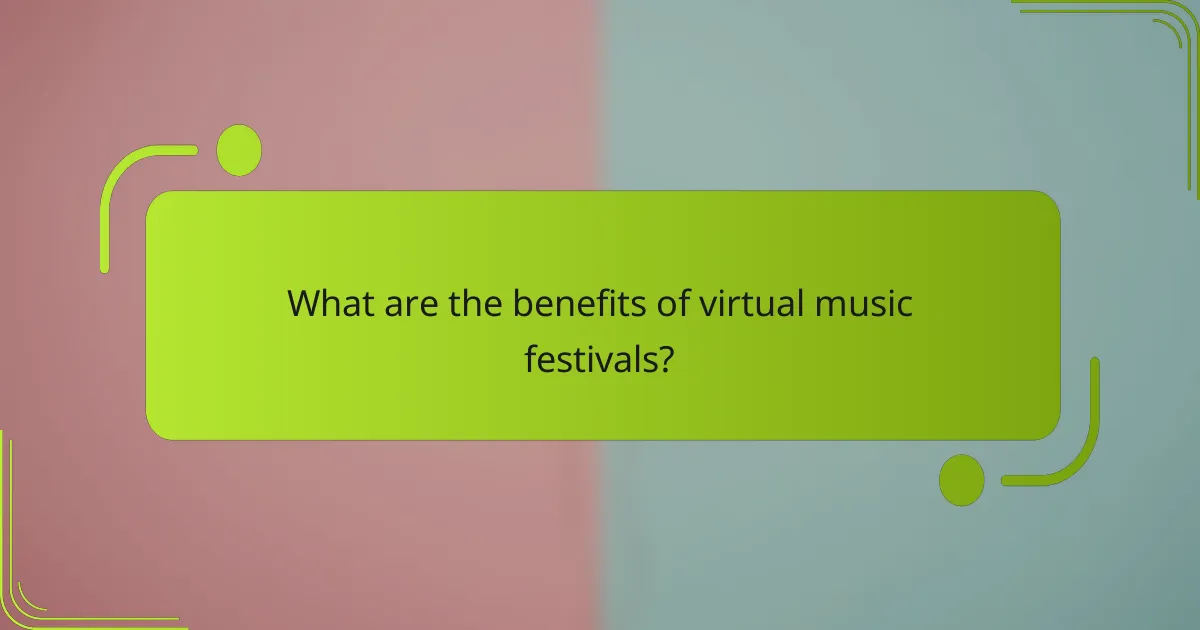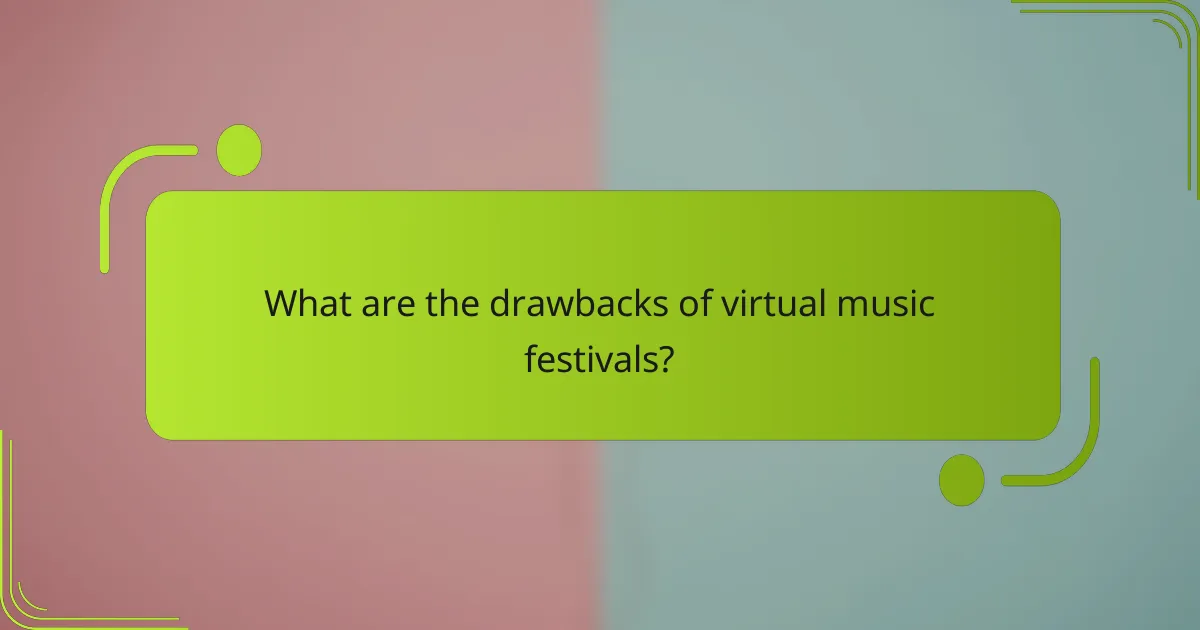Virtual music festivals have emerged as a popular alternative to traditional events, offering unique benefits such as broader accessibility and cost savings for both organizers and attendees. However, they also present challenges, including the absence of physical presence and potential technical issues that can impact the overall experience. As these digital gatherings continue to evolve, they provide a distinct atmosphere that prioritizes convenience while reshaping how audiences engage with live music.

What are the benefits of virtual music festivals?
Virtual music festivals offer numerous advantages, making them an appealing alternative to traditional events. They provide access to a wider audience, reduce costs for both organizers and attendees, and create unique interactive experiences.
Global accessibility
One of the primary benefits of virtual music festivals is their global accessibility. Fans from various countries can join without the need for travel, allowing for a diverse audience that might not be able to attend in-person events due to geographical or financial constraints.
This accessibility enables artists to reach a broader fan base, fostering a more inclusive atmosphere. For example, a festival based in the U.S. can attract viewers from Europe, Asia, and beyond, enhancing cultural exchange and appreciation.
Cost-effectiveness
Virtual music festivals tend to be more cost-effective for both organizers and attendees. Without the expenses associated with physical venues, such as rental fees, security, and logistics, organizers can allocate resources to enhance the online experience.
Attendees also save on travel, accommodation, and food costs, making it easier for a larger number of people to participate. Ticket prices are often lower, allowing fans to enjoy performances without breaking the bank.
Diverse lineups
Virtual music festivals can feature a more diverse lineup of artists compared to traditional festivals. Organizers are not limited by physical space, allowing them to showcase a wide range of genres and performers from different regions.
This diversity enriches the festival experience, exposing attendees to new music and cultures. For instance, a festival might include indie bands from South America, electronic artists from Europe, and hip-hop acts from North America, creating a vibrant musical tapestry.
Interactive experiences
Many virtual music festivals incorporate interactive elements that enhance viewer engagement. Features such as live chats, Q&A sessions, and virtual meet-and-greets allow fans to connect with artists and other attendees in real-time.
These interactions can create a sense of community and belonging, similar to what fans experience at in-person events. Additionally, some festivals offer gamification elements, such as scavenger hunts or contests, to further engage participants.
Reduced environmental impact
Virtual music festivals significantly reduce the environmental impact associated with traditional events. By eliminating the need for travel and large-scale infrastructure, these festivals contribute to lower carbon emissions and less waste.
Moreover, organizers can utilize digital platforms that require less energy than physical venues. This shift not only benefits the environment but also aligns with the growing awareness of sustainability in the music industry.

What are the drawbacks of virtual music festivals?
Virtual music festivals have several drawbacks that can affect the overall experience for attendees. Key issues include the lack of physical presence, potential technical problems, limited opportunities for social interaction, and variable production quality.
Lack of physical presence
The absence of a physical venue can diminish the excitement and energy typically found at live music events. Attendees miss out on the atmosphere created by being surrounded by fellow fans and experiencing the music in real-time. This can lead to a sense of isolation, as the communal aspect of enjoying live performances is lost.
For many, the thrill of live music comes from the shared experience of being in a crowd, dancing, and connecting with others. Virtual festivals often struggle to replicate this sense of community, which can make the experience feel less engaging.
Technical issues
Technical difficulties can significantly hinder the enjoyment of virtual music festivals. Common problems include poor internet connectivity, audio lag, and video buffering, which can disrupt the flow of performances. These issues may lead to frustration and a diminished experience for viewers.
To mitigate technical issues, participants should ensure they have a reliable internet connection and consider using wired connections over Wi-Fi when possible. Testing devices and platforms ahead of time can also help identify potential problems before the event begins.
Limited social interaction
Virtual music festivals often provide limited opportunities for social interaction compared to their in-person counterparts. While some platforms offer chat features, they may not foster meaningful connections like face-to-face interactions do. This can leave attendees feeling disconnected from the festival experience.
To enhance social engagement, participants can organize virtual meetups or join online communities related to the festival. Engaging with others through social media can also help recreate a sense of camaraderie, even if it’s not the same as being physically present.
Variable production quality
The production quality of virtual music festivals can vary widely, impacting the overall experience. Some events may feature high-quality audio and visuals, while others might struggle with subpar streaming or inadequate sound mixing. This inconsistency can affect how attendees perceive the performances.
When selecting a virtual festival to attend, researching the event’s production standards can be beneficial. Reading reviews or checking past performances can provide insights into what to expect, helping attendees choose events that prioritize quality and enhance their experience.

How do virtual music festivals compare to in-person events?
Virtual music festivals offer a different experience compared to in-person events, primarily in terms of accessibility and atmosphere. While in-person festivals provide a tangible communal experience, virtual events focus on convenience and reach, allowing attendees from various locations to participate without travel costs.
Experience differences
The experience at virtual music festivals is often characterized by a lack of physical presence, which can diminish the energy and excitement typically felt at live events. Attendees may miss out on the immersive atmosphere created by live performances, crowd interactions, and the festival environment.
However, virtual festivals can provide unique features such as interactive chat rooms, virtual meet-and-greets, and access to exclusive behind-the-scenes content. These elements can enhance the experience for those who prefer a more personalized engagement.
Cost comparison
In-person festivals usually involve significant expenses, including ticket prices, travel, accommodation, and food, which can add up to hundreds or even thousands of dollars. In contrast, virtual music festivals often have lower ticket prices, sometimes even offering free access, making them more financially accessible.
While virtual events eliminate many travel-related costs, attendees may still incur expenses for high-quality streaming services or merchandise. It’s essential to weigh these costs against the benefits of convenience and accessibility when deciding which type of festival to attend.
Audience engagement
Audience engagement at in-person festivals is typically high, driven by the energy of live performances and the social interactions among attendees. This dynamic fosters a sense of community and shared experience that can be hard to replicate online.
Virtual festivals, on the other hand, utilize technology to engage audiences through interactive features like polls, live chats, and social media integration. While these tools can enhance participation, they may not fully capture the spontaneous interactions that occur in person. Balancing these engagement strategies is crucial for maximizing the virtual festival experience.

What are popular platforms for hosting virtual music festivals?
Popular platforms for hosting virtual music festivals include Twitch, YouTube, Facebook Live, and Veeps. Each platform offers unique features that cater to different audiences and event types, making it essential to choose the right one based on your festival’s goals and target demographic.
Twitch
Twitch is primarily known for gaming but has expanded to include music and creative content. It allows artists to stream live performances and engage with fans through chat, creating an interactive experience. The platform supports monetization through subscriptions and donations, making it appealing for artists looking to earn revenue.
When using Twitch, consider the importance of building a community. Regular streaming and engaging with viewers can help grow your audience over time. However, be mindful of the platform’s guidelines to avoid any potential issues with content moderation.
YouTube
YouTube is a versatile platform for hosting virtual music festivals, allowing for both live streams and pre-recorded content. It has a vast user base, which can help reach a larger audience. YouTube Live enables real-time interaction through chat, enhancing viewer engagement during performances.
To maximize your festival’s impact on YouTube, promote the event in advance and utilize social media to drive traffic to your stream. Keep in mind that monetization options include ad revenue and Super Chat, which allows fans to pay for highlighted messages during live streams.
Facebook Live
Facebook Live is integrated within the Facebook ecosystem, making it easy to reach existing followers and their networks. It allows artists to stream live performances directly to their audience’s news feeds. The platform supports real-time interaction through comments, fostering a sense of community among viewers.
When using Facebook Live, promote your event through posts and stories to maximize visibility. Be aware that the platform’s algorithm may affect how many people see your stream, so consider boosting posts for wider reach if your budget allows.
Veeps
Veeps is a platform specifically designed for artists to host live streams and sell tickets for virtual events. It focuses on providing a seamless experience for both performers and fans, with features like ticket sales, merchandise integration, and high-quality streaming options. This makes it an excellent choice for artists looking to monetize their performances directly.
When planning a festival on Veeps, ensure that you promote ticket sales well in advance. The platform allows for customizable ticket pricing, which can help cater to different audience segments. However, be prepared to handle customer service inquiries related to ticketing and access issues.

What are key factors to consider when attending a virtual music festival?
When attending a virtual music festival, important factors include your internet connection and time zone differences. These elements can significantly impact your overall experience and enjoyment of the event.
Internet connection
A stable and fast internet connection is crucial for enjoying a virtual music festival. Ideally, you should have a broadband connection with speeds of at least 10 Mbps to ensure smooth streaming without interruptions.
Consider using a wired connection instead of Wi-Fi if possible, as this can reduce latency and improve reliability. If you’re on Wi-Fi, try to minimize the number of devices connected to your network during the event to enhance performance.
Time zone differences
Time zone differences can affect your ability to participate in live performances at a virtual music festival. Be sure to check the festival’s schedule and convert the times to your local time zone to avoid missing any acts.
Many festivals offer recorded performances after the live events, so if you can’t attend in real-time, you may still enjoy the shows later. However, check if there are any limitations on access to recorded content, as some festivals may restrict viewing to a specific time frame.


